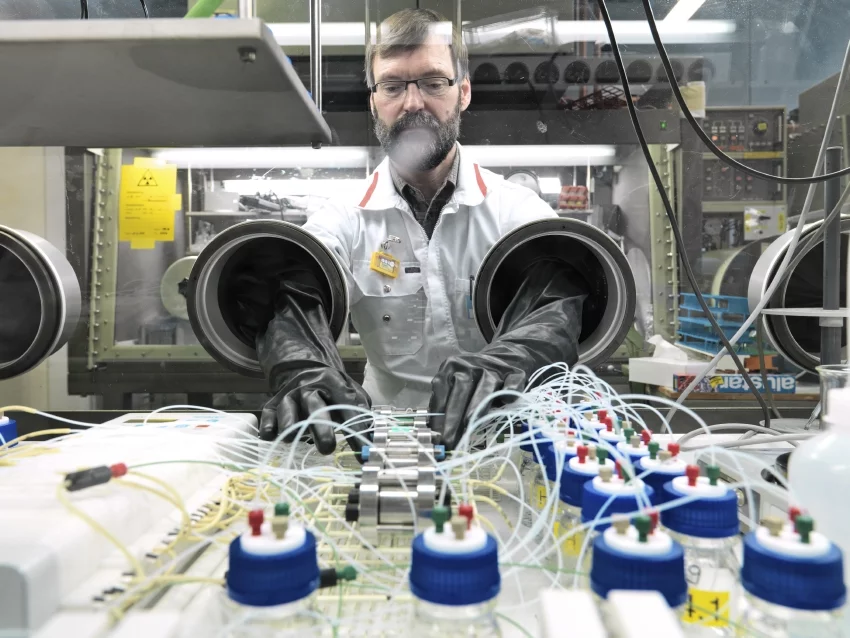Radioactive waste from nuclear power plants - as well as from medicine, industry and research - has to be kept away from the environment, and especially from the habitat of human beings, for a very long time. Parliament envisages the disposal of this waste deep under the surface of the Earth in geological repositories. Experts at PSI have been occupied for many years with scientific questions concerning of the safety case for geological repositories, for which NAGRA (the National Cooperative for the Disposal of Radioactive Waste) is responsible.
PSI research is devoted above all to the physicochemical processes that take place in radioactive waste disposal systems. It aims to dispel uncertainties through site-specific information and to arrive at a realistic description of the risks associated with radioactive waste disposal. It is addressing questions concerning the mobility of radionuclides in the specific environment of the repository, the mechanisms which bind the radionuclide to rocks and cement, and also the transport of radionuclide in rock, in deep water and in cement. PSI experts are studying this complex behaviour in their own laboratories and in underground rock laboratories in Switzerland - one at Mont Terri in the Jura mountains and one in the Grimsel region. They are developing models and testing these in specially designed experiments to try and find answers to the question as to how the results of comparatively small-scale and short-term laboratory tests can be extrapolated to the large spatiotemporal dimensions of a repository. This research is being conducted in close collaboration with NAGRA, and also with universities and research centres both at home and abroad.
Safe disposal of radioactive waste in Switzerland
How is it possible to guarantee the safety of a repository for radioactive material over thousands or even millions of years, and to do so using measurements taken over only a few years? Incomprehensible though this may seem, conclusions on such long periods can be drawn with surprising scientific accuracy for important and precisely defined processes - e.g. for certain types of clay (opalinus clay), which are designed to serve as natural barriers for radioactive material in a deep repository. Clay has a complex structure. Many extremely thin layers, comprising only a few water molecules and also relatively large pores filled with water, confer plasticity on the clay, which is important, for example, in pottery (the thin water layers act as a lubricant). The water molecules adhere to the clay and are therefore replaced only very slowly. The transport of radioactive material through a layer of clay therefore practically occurs only through the thermal movement of the water molecules and the dissolved materials, i.e. through diffusion. It is understandable that, with increasing temperature (and thus the greater the movement of the molecules), this process becomes faster and the molecules adhere less well to the clay matrix (chemical properties such as pH value and the nature or mineralogical composition of the clay are important for this).
At PSI, scientists have studied the transport of water through clay samples using two independent methods:
- Macroscopic, centimetre-scale tracer measurements
- Microscopic, nanometre-scale studies using neutron scattering experiments (1 nanometre = 1 millionth of a millimetre).
The macroscopic method uses HTO as the tracer, which are water molecules in which a hydrogen atom (H) is replaced by radioactive tritium (T). By measuring the radioactivity, it is possible to establish how quickly the water molecules migrate through a 1-cm-thick clay sample.
In the microscopic method, using neutron scattering, a beam of neutrons is passed through the test material to observe how the speed (and thus the energy) of the neutrons changes in the process (inelastic neutron scattering). Since the neutrons can transmit their energy best to the smallest (hydrogen) atoms (by analogy, the speed of a billiard ball does not change significantly when it bounces from the cushion of the table, but does change when it collides with another ball of equal size), the change in speed yields information in particular on the movement of water molecules and not on those of the clay matrix.
The scientists have succeeded in reaching agreement between the results of the two completely different methods (whose scales differ by a factor of 10 million) and a single model concept embracing both methods. In addition, they have correlated the temperature dependence with lower-lying physicochemical principles (activation energy). This work serves as an important contribution towards understanding the transport processes through clay layers and thus towards safer predictions of the behaviour of a repository over a wide range of temperatures and long periods of time.

